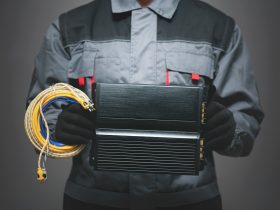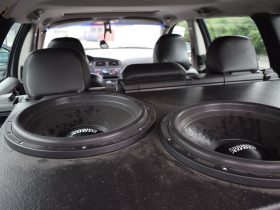Road trips are incomplete without a personalized playlist to listen to on the go. Whether you’re driving solo, or going on a hike with friends, you better have quality music to groove to. Add in a quality amplifier or speaker as well. This will help the music to be crisp and clear.
To be honest with you, a car amplifier is a must-have for all the music enthusiasts out there. But what kind of car amplifier is the best for your car, and… you?
Before we begin, let’s get a brief idea about what car amplifiers are, and what purpose they serve.
Well, you’ve probably guessed it already, but let me spell it out for you. An amplifier is an electronic device that is used for strengthening a weak audio signal.
The audio signal that goes into the speaker can often turn out to be too weak to drive the speaker. An amplifier can strengthen the signal and make it loud and distortion-free.
But what amplifier should you be getting for your car? Digital, or analog? How are the two different from each other, anyway? Why do you need an amplifier for your car in the first place? Here we’ll be telling you all about car amps, which ones might suit your needs the best, and why.
So, hop in and fasten your seatbelts. It’s going to be a fun ride!
Why Do I Need A Car Amplifier?
The primary benefits offered by a car amplifier mainly include a better, clearer, and louder sound. But that’s way too general and anybody can assume. Let me break it down for you in as much detail as possible.
They Provide A Louder Sound Without Distortion
When you hit the road on a fun trip with friends… surely, you’d want to listen to something upbeat that you could sing and groove along to.
For doing that, you might want to put the volume levels a bit high. If you’ve got an amplifier in your car, you’d be able to up the sound level as much as you want without increasing the distortion along with it too.
Amplifiers Power Your Car’s Subwoofer
If you decide to add a subwoofer to your car’s audio system, you must add an amplifier along with it to connect it. Car radios don’t usually have connections that are compatible with subwoofers. You’d need an amp to make that connection between them.
An Amplifier Helps You to Get the Most Out of Your Speakers
You can get as many new speakers as you want, and they will sound good. But not as good as adding an amp to the audio system.
An amp can even make your car’s default factory audio system sound amazing. What type of speakers you get, matters. But whether you have an amp or not matters even more. A good amplifier has the power to change your listening experience for the better.
Okay, What is a Digital Amplifier?
The entire audio industry took a turn when digital amplifiers were first invented back in 1998. Due to their ease of use, convenience, and power-packed performance, they became immensely popular within a short time.
During the first few years, it was expensive to produce true digital sound. Because a huge number of computer chips were required to transfer audio signals consistently from the source to the speakers.
But with the passing of time and the advancement of technology, the number of chips needed to get the job done has been reduced and the costs behind manufacturing digital audio devices could be dragged down to a bare minimum.
A digital amplifier is a device that receives digital audio inputs from its source. Then, digitally converts the signal from its original linear pulse code format to a Pulse Width Modulation.
This is better known as the PWM format. The part of the digital amplifier that does the job, known as the Pulse Width Modulator comes into the fray. It produces a signal very high in voltage which gets filtered and makes a replica of the original sound.
But to produce the exact replica accurately, the signal’s timing and alignment should be exactly the same while it transfers. This is where the speaker terminals come to the rescue. They synthesize the signals, reducing most of the background and mechanical noise that comes along with the signal.
Best Budget Mono Car Amplifier
What is an Analog Amplifier?
Analog amplifiers have almost gone obsolete ever since the emergence of digital ones. I mean, seriously… You could probably still find one in grandpa’s old garage somewhere.
But its usability would be under question. That’s why I mentioned these after the digital amplifiers, just to provide you with a basic textbook definition of what they do, and a brief description of how they do it.
As you’ve probably guessed already, an analog amplifier is the predecessor of the digital one.
Instead of reproducing the original sound digitally, it delivered the original sound without any filtering and modification. Along with a lot of distortion, background noises, and machine noises from the amplifier itself.
In fact, the sound produced by the analog amplifiers often came out as ‘chirpy’, kinda like the audio effect of an old radio that’s used in many songs these days. Only it wasn’t an effect back then, it was really how they sounded like. Pretty hard to believe, eh?
Later on, they started using ‘converters’ to make the audio sound somewhat audible. By the 1950s, D.H. Wilkinson had already started modifying sound by using Analog to Digital converters.
These ‘converters’, as they called them, produced a much clearer, noiseless sound in comparison to their earlier versions. But still, they somehow lacked the clarity of sound that the music enthusiasts and sound geeks were craving for. Thus, digital amps were born.
Similarities Between the Two
Both analog and digital amplifiers are designed to provide you with a crisp listening experience. It’s noise and distortion-free. But despite the digital ones doing the job better than the analog ones. However, the two types have some basic similarities between them. Here they are:
- Both analog and digital amplifiers convert audio signals and reproduce them out of the speakers.
- Both enhance the original sound produced by the source and try to make it louder and clearer.
- Both the amplifiers work as connectors between the car’s radio and subwoofers.
Do you Need an Amp for Door Speakers?
Differences They Have
The differences between a digital and an analog car amplifier are huge. The digital one is a complete upgrade of the entire technology and mechanism of how amplifiers work.
The invention of the digital amplifier changed the face of the audio industry for good. Here are some of the basic differences between digital and analog car amplifiers:
- Analog amplifiers have much less overload capacity and power reserve compared to digital ones. Causing distortions that increase exponentially, deteriorating the sound quality with the increasing of the overload.
- Analog amps tend to have a large internal resistance in the power amplifier tube. This makes it difficult to match it with the resistance values of the speakers connected to them. Digital amplifiers on the other hand, are always in the saturation zone and cut-off zone all the while during the amplification. This makes matching the power amplifier and the speakers no trouble with digital amplifiers.
- The negative feedback circuits used by most analog power amplifiers cause transient intermodulation distortion. But there’s no other option because these circuits are necessary. This is to ensure the electroacoustic indicators are running. The digital amplifier doesn’t require such circuits for power conversion but still prevents distortion.
- In the case of analog amplifiers, there’s a phase gap between the input and the output signals. This happens due to the huge internal resistance they have in the tube. When the output power differs from the input power, the phase distortion also turns out different. On the other hand, the digital amplifier does not have any phase differences. It uses digital audio signal amplification to match the two signals consistently, leaving zero gaps between the phase shifts. This keeps the sound image positioning accurate with digital amplifiers.
- Analog amplifiers tend to have a lot of debugging problems at almost all points of their operation. This makes them inefficient for mass production. Digital amps are their complete opposite, in this case, functioning totally on digital circuits that require no debugging at all. Making them an ideal product for mass manufacturing.
My Final Two Cents!
Amps are basically the music lover’s best friend. They have the power to make even entry-level speakers sound incredibly top-notch. That too with a fraction of the cost of our actual speakers.
When it comes to comparing Digital vs Analog Amplifiers, I have to side with the digital ones. Analog amps are great. However, they have far too many chinks in the armor to be called worthy additions to our cars. Digital Amps solve everything without us meddling with them. Well, mostly!
Whichever amp you choose to get, analog or digital, make sure that your main unit, which is your car’s default sound system, has preamp outputs.
These outputs are what make the amp work by bypassing the car’s built-in amplifier (if there is any). They send a clear signal to the amp you’ll be setting up with it externally.
If your car does not have preamp outputs, in that case you’ll need an amp that has speaker-level inputs. Or, you could use a speaker to the line-level converter. But the downside of both of these methods is that they’d have some distortion.
If you don’t mind a little bit of distortion, then you can go for these options. Otherwise, just get yourself a new head unit and build a new sound system for your car from scratch.
More Related Articles:









